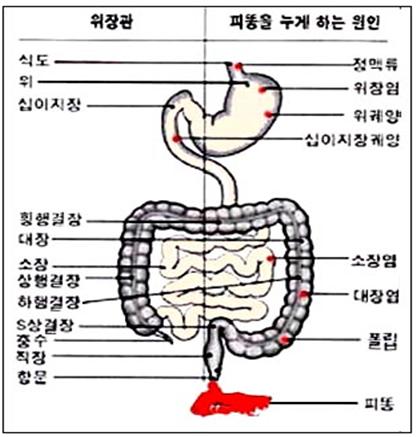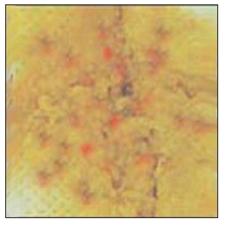신생아의 혈변, Bloody stool of newborn infants

그림 108. 소화관의 구조와 신생아가 피똥을 눌 때.
태어나는 아기가 질 산도에서 흘린 모체 피를 삼킨 후 삼킨 피를 전부 토하거나 그 피의 일부를 대변으로 눌 수 있다.
혈소판 기능 장애나 혈소판 감소증 등으로 혈변을 볼 수 있다.
모유 수유 중 수유모 젖꼭지에서 나는 피를 삼킨 후 혈변을 볼 수 있다.
인공영양 속에 든 우유 단백질이나 콩 단백질 알레르기로 위장 관에서 피가 나고 그로 인해 피똥을 눌 수 있다.
Copyright ⓒ 2013 John Sangwon Lee, MD., FAAP
- 이미 간략하게 “신생아가 피를 토할 때나 혈변을 눌 때” 설명했지만 여기서 다시 설명한다.
- 갓 태어나서 생후 28일까지의 기간을 신생아기라 한다.
- 이 기간 동안 신생아가 피똥을 눌 수 있다.
- 신생아가 눈 피똥을 신생아의 혈변이라 한다.
- 신생아 자신의 소화관에서 난 피가 위장 관을 통과하는 동안 통과 하는 기간에 따라 혈색이 변화될 수 있다.
- 위장관에서 혈색이 변화되면 혈색이 커피색과 비슷할 수 있고 커피색과 비슷한 대변을 볼 수 있다.
- 때로는 소화관 중 위장 관에서 난 새빨간 피가 위장 관내에서 조금도 변화되지 않고 대변에 새빨간 피로 그냥 나오는 경우도 있다.
- 또 위장관에서 피가 조금씩 계속 날 때는 그 피가 대변 속에 골고루 섞여 대변에 피가 나 있는지 육안으로 식별할 수 없다. 이와 같이 대변에 피가 섞여 있지만 육안으로 대변에 피가 있는지 식별할 수 없는 위장 출혈을 대변 잠혈 또는 대변 잠재혈액(Occult blood)이라고 한다.
- (신생아에게 출혈이 생길 때, 피똥을 눌 때, 혈변 참조).
| 신생아의 혈변의 원인 |
- 분만 중 질 산도 속에서 모체의 피를 삼킨 후 태어난 신생아는 삼킨 모체의 피의 대부분을 토할 수도 있고 삼킨 피의 일부를 토하고 나머지는 소화관을 통해서 항문으로 나올 수도 있다.
- 아기가 삼킨 피가 소화관을 통과하는 동안 빨간색 피가 커피색으로 변화될 수 있다.
- 분만 중 다량으로 삼킨 모체의 피가 신생아의 위장관에서 변화되지 않거나 변화될 시간 여유가 없이 항문으로 그냥 빨간색 피로 나올 때도 있다. 이 때 항문으로 나온 피는 대개가 붉거나 빨갛다.
- 분만 중 질 산도 속에서 모체의 피를 삼키지 않은 신생아에게 전신 출혈성 질환이 있거나 어떤 소화관 질환이 있을 때 신생아의 소화관에서 피가 날 수 있고 그로 인해 혈변을 볼 수 있다.
- 바이러스 위장염이나 박테리아 위장염, 우유 단백이나 콩 단백질 인공영양 알레르기로 위장관에서 출혈할 수 있다. 그로 인해 혈변을 볼 수 있다.
| 신생아의 혈변의 진단 치료 |
- 병력 증상 징후 진찰소견 등을 종합해서 진단한다.
- 혈변의 원인과 정도에 따라 CBC 피 검사, 간 기능검사, 혈액응고 검사, 대변 세균 검사, 대변 잠혈 검사 등으로 진단한다.
- 육안으로 볼 수 없는 잠재혈액은 대변 잠혈 검사로 진단한다.
- 대변에 피가 나 있다고 확실히 진단이 나면 그 피가 아기에게서 나온 피 인지 엄마로부터 나온 피 인지 가려내야 한다.
- 대변에 있는 피가 신생아에게서 난 피라고 진단이 나면 그 피가 아기의 소화관에서 난 피인지 신체 어느 부위에서 나온 피 인지 알아보고 그 출혈의 원인, 정도 등에 따라 치료한다.
- 우유 단백질이나 콩 단백질로 만든 인공영양으로 신생아의 혈변이 생기면 그 인공영양을 더 이상 먹이지 말고 뉴트라미젠이나 다른 종류의 저 알레르기성 인공영양을 먹인다.

사진 109. 신생아 혈변
Copyright ⓒ 2013 John Sangwon Lee, MD., FAAP
Bloody stool of newborn infants 신생아의 혈변

Fig. 108. The structure of the digestive tract and when a newborn baby passes bloody stool. After a newborn baby swallows maternal blood from the vaginal birth canal, it is possible to vomit all of the swallowed blood or to press part of the blood into the stool.
The bloody stool can be seen due to platelet dysfunction or thrombocytopenia.
Bloody stools can be seen after swallowing blood from the breastfeeding mother’s nipples while breastfeeding.
An allergy to milk protein or soy protein in artificial nutrients can cause bleeding in the gastrointestinal tract, resulting in bloody stools. Copyright ⓒ 2013 John Sangwon Lee, MD., FAAP
I have already briefly explained “when a newborn baby vomits blood or passes bloody stool”, but it will be explained again here.
The period from newborn to 28 days after birth is called the newborn period. During this period, the newborn can shed blood.
A newborn passes blood stools.
The blood color of the newborn’s own digestive tract can change depending on how long the blood passes through the gastrointestinal tract.
If the blood color changes in the gastrointestinal tract, the color may resemble coffee color and you may have stool similar to coffee color.
Sometimes, the red blood from the gastrointestinal tract of the digestive tract does not change at all in the gastrointestinal tract, and the red blood in the stool just comes out.
In addition, when the blood flows little by little from the gastrointestinal tract, the blood is mixed evenly in the stool, making it impossible to visually identify whether there is blood in the stool.
In this way, gastrointestinal bleeding in which the stool contains blood but cannot visually identify whether there is blood in the stool is called stool occult blood or stool occult blood. (See bleeding in newborns, pressing blood dung, bloody stools).
Causes of bloody stools in newborns
Newborns born after swallowing the mother’s blood in the vaginal birth canal during delivery may vomit most of the mother’s blood or part of the swallowed blood and the rest may come out through the digestive tract and into the anus.
The red blood can turn a coffee color while the blood swallowed by the baby passes through the digestive tract.
There are times when the maternal blood, swallowed in large quantities during delivery, does not change in the newborn’s gastrointestinal tract or just comes out of red blood through the anus without time to change.
At this time, the blood from the anus is usually red.
Newborns who have not swallowed maternal blood in the vaginal birth canal during delivery can bleed from the newborn’s digestive tract, resulting in the bloody stool when a newborn has a systemic hemorrhagic disease or some digestive tract disease. Viral gastroenteritis, bacterial gastroenteritis, milk protein or soy protein artificial nutritional allergy can cause bleeding from the gastrointestinal tract.
This can lead to bloody stool.
Diagnostic treatment of bloody stool in newborns Comprehensive diagnosis including medical history, symptoms, signs, and examination findings.
Depending on the cause and degree of bloody stool, it is diagnosed with CBC blood test, liver function test, blood coagulation test, fecal bacteria test, and fecal occult blood test. Latent blood that cannot be seen with the naked eye is diagnosed with a fecal occult blood test.
If you are sure that your stool is bleeding, you need to determine whether the blood is from the baby or from the mother.
If it is diagnosed that the blood in the stool is from a newborn, find out whether the blood is from the baby’s digestive tract or from which part of the body, and treat it according to the cause and degree of the bleeding.
If the newborn has a bloody stool with artificial nutrition made with milk protein or soy protein, stop feeding the artificial nutrition and feed Nutramigen or other types of hypoallergenic artificial nutrition.

Picture 109. Bloody feces in newborns. Copyright ⓒ 2013 John Sangwon Lee, MD., FAAP
출처 및 참조 문헌
- NelsonTextbook of Pediatrics 22ND Ed
- The Harriet Lane Handbook 22ND Ed
- Growth and development of the children
- Red Book 32nd Ed 2021-2024
- Neonatal Resuscitation, American Academy Pediatrics
- www.drleepediatrics.com 제1권 소아청소년 응급 의료
- www.drleepediatrics.com 제2권 소아청소년 예방
- www.drleepediatrics.com 제3권 소아청소년 성장 발육 육아
- www.drleepediatrics.com 제4권 모유,모유수유, 이유
- www.drleepediatrics.com 제5권 인공영양, 우유, 이유식, 비타민, 미네랄, 단백질, 탄수화물, 지방
- www.drleepediatrics.com 제6권 신생아 성장 발육 육아 질병
- www.drleepediatrics.com제7권 소아청소년 감염병
- www.drleepediatrics.com제8권 소아청소년 호흡기 질환
- www.drleepediatrics.com제9권 소아청소년 소화기 질환
- www.drleepediatrics.com제10권. 소아청소년 신장 비뇨 생식기 질환
- www.drleepediatrics.com제11권. 소아청소년 심장 혈관계 질환
- www.drleepediatrics.com제12권. 소아청소년 신경 정신 질환, 행동 수면 문제
- www.drleepediatrics.com제13권. 소아청소년 혈액, 림프, 종양 질환
- www.drleepediatrics.com제14권. 소아청소년 내분비, 유전, 염색체, 대사, 희귀병
- www.drleepediatrics.com제15권. 소아청소년 알레르기, 자가 면역질환
- www.drleepediatrics.com제16권. 소아청소년 정형외과 질환
- www.drleepediatrics.com제17권. 소아청소년 피부 질환
- www.drleepediatrics.com제18권. 소아청소년 이비인후(귀 코 인두 후두) 질환
- www.drleepediatrics.com제19권. 소아청소년 안과 (눈)질환
- www.drleepediatrics.com 제20권 소아청소년 이 (치아)질환
- www.drleepediatrics.com 제21권 소아청소년 가정 학교 간호
- www.drleepediatrics.com 제22권 아들 딸 이렇게 사랑해 키우세요
- www.drleepediatrics.com 제23권 사춘기 아이들의 성장 발육 질병
- www.drleepediatrics.com 제24권 소아청소년 성교육
- www.drleepediatrics.com 제25권 임신, 분만, 출산, 신생아 돌보기
- Red book 29th-31st edition 2021
- Nelson Text Book of Pediatrics 19th- 21st Edition
- The Johns Hopkins Hospital, The Harriet Lane Handbook, 22nd edition
- 응급환자관리 정담미디어
- Pediatric Nutritional Handbook American Academy of Pediatrics
- 소아가정간호백과–부모도 반의사가 되어야 한다, 이상원 저
- The pregnancy Bible. By Joan stone, MD. Keith Eddleman, MD
- Neonatology Jeffrey J. Pomerance, C. Joan Richardson
- Preparation for Birth. Beverly Savage and Dianna Smith
- 임신에서 신생아 돌보기까지. 이상원
- Breastfeeding. by Ruth Lawrence and Robert Lawrence
- Sources and references on Growth, Development, Cares, and Diseases of Newborn Infants
- Emergency Medical Service for Children, By Ross Lab. May 1989. p.10
- Emergency care, Harvey Grant and Robert Murray
- Emergency Care Transportation of Sick and Injured American Academy of Orthopaedic Surgeons
- Emergency Pediatrics A Guide to Ambulatory Care, Roger M. Barkin, Peter Rosen
- Quick Reference To Pediatric Emergencies, Delmer J. Pascoe, M.D., Moses Grossman, M.D. with 26 contributors
- Neonatal resuscitation Ameican academy of pediatrics
- Pediatric Nutritional Handbook American Academy of Pediatrics
- Pediatric Resuscitation Pediatric Clinics of North America, Stephen M. Schexnayder, M.D.
-
Pediatric Critical Care, Pediatric Clinics of North America, James P. Orlowski, M.D.
-
Preparation for Birth. Beverly Savage and Dianna Smith
-
Infectious disease of children, Saul Krugman, Samuel L Katz, Ann A.
- 제4권 모유, 모유수유, 이유 참조문헌 및 출처
- 제5권 인공영양, 우유, 이유, 비타민, 단백질, 지방 탄수 화물 참조문헌 및 출처
- 제6권 신생아 성장발육 양호 질병 참조문헌 및 출처
- 소아과학 대한교과서
|
Copyright ⓒ 2015 John Sangwon Lee, MD., FAAP 미국 소아과 전문의, 한국 소아청소년과 전문의 이상원 저 “부모도 반의사가 되어야 한다”-내용은 여러분들의 의사로부터 얻은 정보와 진료를 대신할 수 없습니다. The information contained in this publication should not be used as a substitute for the medical care and advice of your doctor. There may be variations in treatment that your doctor may recommend based on individual facts and circumstances. “Parental education is the best medicine.” |